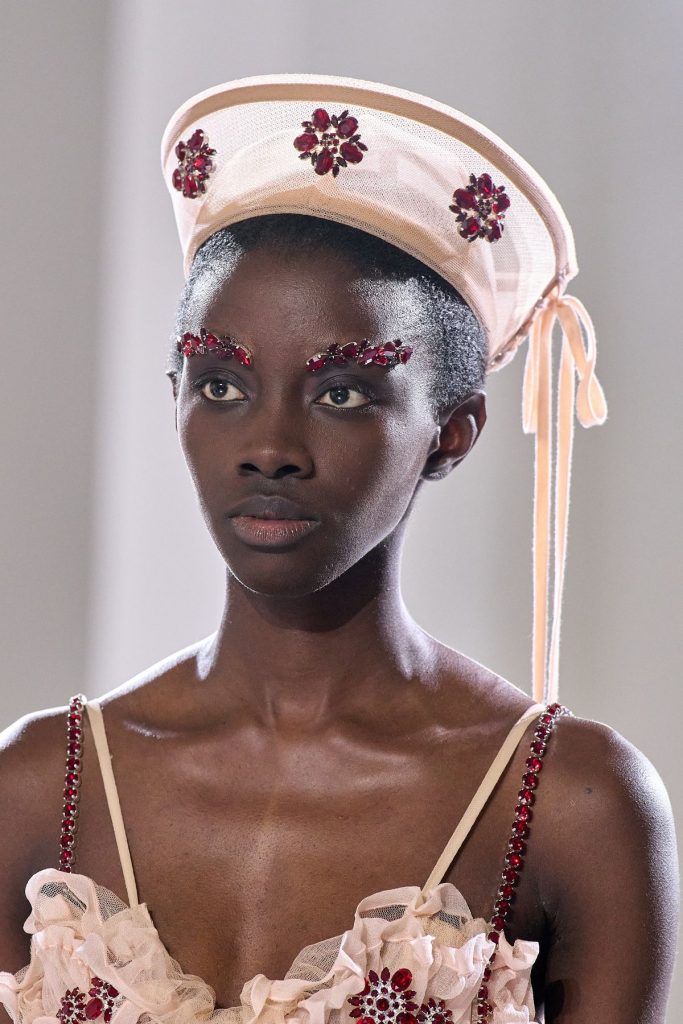Once associated with traditional men’s uniforms, the accessory is now being reclaimed by a generation blurring gender boundaries. Mixing performance, identity, and a nod to Gaultier, its comeback reflects a fashion scene that’s freer than ever.
A viral revival on TikTok
Since September, TikTok has been flooded with DIY takes on the sailor hat. The unexpected trend is driven by users openly drawing inspiration from the world of Jean-Paul Gaultier, the ultimate master of the sailor aesthetic. One creator even directly references the house’s Spring-Summer 2024 couture collection by Simone Rocha, where the sailor hat emerges as a neo-romantic accessory.



Even if this couture reference is out of reach for most, the trend is spreading thanks to DIY: making your own sailor hat has become a creative, anti-consumerist statement. The piece requires minimal materials and can be created from fabric scraps, making it affordable, highly customizable, and sustainable.
This handcrafted approach stands in stark contrast to TikTok’s recent evolution into a full-on shopping platform. The fact that this trend centers on making rather than buying is rare enough to be worth noting. In the same spirit, some responsible brands such as Salt hats offer versions made from upcycled textiles, reinforcing the idea that the sailor hat is not just a fashion accessory but also a canvas for sustainable experimentation.
A signature element of Jean-Paul Gaultier’s iconic sailor look
If the sailor hat is enjoying a triumphant comeback today, it’s largely thanks to the legacy of Jean-Paul Gaultier. In 1983, the designer unveiled his menswear collection “L’Homme objet,” a major turning point in his career. It was there that he introduced his own take on the sailor shirt, already popularized by Coco Chanel and later Yves Saint Laurent and began shaping what would become one of his most iconic hallmarks: the sailor silhouette.



Alongside the sailor shirt, reimagined over the years on runways, in ad campaigns, and even on the brand’s perfume bottles. The sailor hat has become an iconic accessory. The house continues to reinvent it today, in leather, denim, or stripes, turning it into an instantly recognizable marker of the Gaultier aesthetic. Through his reinterpretation of the sailor look, the designer reshaped the codes of masculinity, offering a distinctly queer alternative.
A unisex piece reinvented by Gen Z
The sailor hat’s comeback must also be understood through a gendered lens. Inherited from the Jean-Paul Gaultier universe, it carries a strong symbolic weight tied to gender fluidity and queer expression. Since the 1980s, Gaultier has used the sailor look to question masculinity, an overtly virile, military uniform infused with theatrical, almost camp energy. By incorporating the sailor hat into his silhouettes, he transformed it into an accessory charged with ambiguity.


Today, this dimension is being fully reclaimed by Gen Z, who embrace it as a gender-fluid piece. On TikTok and on the runways of emerging designers, the sailor hat appears in contexts where gender is intentionally challenged: worn with sheer dresses, oversized suits, romantic ensembles, or streetwear looks, it takes on the role of a true symbol.
The accessory functions almost like a costume: it allows the wearer to step into a character and explore multiple identities. For many TikTok users, especially within queer communities, it turns into a tool of empowerment as well as cultural reclamation. A nod to Gaultier, an iconic figure of queer fashion and a pioneer of LGBTQIA+ visibility on the runway.
In this context, the sailor hat rises far above the status of a fleeting trend. It becomes a political canvas, an object carrying the weight of decades of Gaultier’s creative history, now steered by Duran Lantink. What if a couture-born accessory were to become the emblem of an entire DIY generation?









